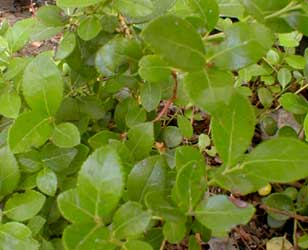
'Bloodstone'
Rayner's Creeping Blueberry
Vaccinium crassifolium ssp sempervirens 'Bloodstone' is a short, six to eight inch tall, spreading evergreen groundcover. It produces a few small white flowers beginning late March & April, followed by even fewer sweet blue-black blueberries.
The species is native to the American south where it prefers seepage bogs. The strongly evergreen subspecies is extremely rare in the wild, highly restricted in its distribution in Lexington County of South Carolina. For years it was mistakenly identified as a distinct race of Gaylussacia brachycera or Box Huckleberry, until D. A. Rayner & J. Henderson recognized it as a subspecies of Vaccinium crassifolium.
Because it does not produce a great many fruits, it does not self-seed well, so that colonies remain in small areas. In consequence it is a threatened native shrub that can never be taken from the wild. Fortunately it is in cultivation for the nursery market.
The cultivar 'Bloodstone' is a select strain first discovered by Dr. James R. Ballington amidst seed-grown stocks at North Carolina State University Department of Horticultural Science, & further developed by W. Benson Kirkman in Corvalis, Oregon, at the National Germplasm Repository.
'Bloodstone' was introduced as an ornamental groundcover in 1984, & became a registered cultivar in 1988. It was named for a semi-precious stone mentioned in the Exodus list of twelve sacred gems that decorate the breastplate of the High Priest, & which have come to be keyed to the zodiac with assumed magical properties, or keyed to the months as birthstones. The semi-precious bloodstone is the gem for March, the same month 'Blodstone' will have new red leaves.
'Bloodstone' differs from the wild shrublet in that its stems & leaves are a brighter red in late winter or when new spring growth appears. In our temperate garden, however, it has not much shown this trait, but has remained pretty steadily green year-round.
It likes moist sandy soil. It is sometimes recommended as an alternative to the overly aggressive Vinca minor, but as creeping blueberry requires more sun & more water than vinca, the two plants' preferred locations are not invariably interchangeable. It can become somewhat drought-hardy after it is well-established, but needs reliable watering for at least the first year.